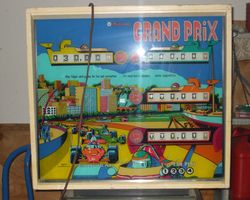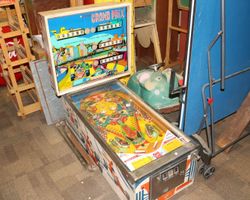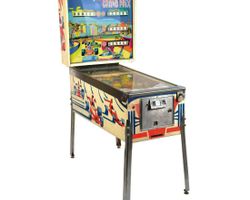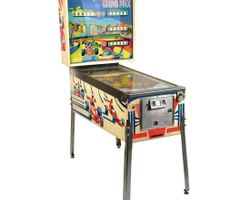Grand Prix

Average Prices: USD $300 to $1,200
Produced: June, 1976
Production Run: 10,554 units
Machine Type: Electro-mechanical
Players: 4
Design by: Steve Kordek
Art by: Christian Marche
The pinball machine "Grand Prix," manufactured by Williams Electronics, Incorporated, emerged in December 1976 as a notable entry in the realm of electro-mechanical (EM) pinball. Designed by Steve Kordek, a prolific figure in the industry, with artwork by Christian Marche, the machine adopted an exhilarating auto racing theme. This thematic choice was a natural fit for the fast-paced action pinball aims to deliver, resonating with a public captivated by motorsport.
Production of "Grand Prix" commenced in June 1976, with the first units shipping out in early July of that year. The primary production run followed, starting in December 1976 and continuing through April 1977. Williams ultimately produced 10,554 units of "Grand Prix," a substantial number for an EM machine of its era, indicating strong market confidence and reception. This volume made "Grand Prix" widely accessible in arcades and public spaces, contributing to its recognition. A unique footnote in its production history is the existence of a few units equipped with solid-state controllers, a precursor to the shift in pinball technology that was already underway. Its playfield layout also shares similarities with Williams' "Liberty Bell," released the same year, suggesting a shared design lineage or experimentation with popular layouts.
Signature Features and Design
"Grand Prix" distinguished itself with several design elements that contributed significantly to its gameplay and appeal. Foremost among these are the two prominent spinning targets positioned in the upper playfield. These "spinners," as they are commonly known, are a central mechanic, designed to be repeatedly struck by the ball, generating rapid rotations and accumulating points. The satisfaction of "ripping" these spinners, sending the ball through them for extended periods, became a defining characteristic of the game.
Beyond the spinners, the playfield features four drop targets. These targets, when knocked down, contribute to a dynamic bonus system, adding a strategic layer to scoring. Two pop bumpers animate the upper playfield, deflecting the ball unpredictably and contributing to the game's overall pace. The machine also incorporates three kick-out holes strategically placed to collect the ball and potentially award points or initiate game features. A unique tilt rollover mechanism in the upper left lane provides an interesting risk-reward element, challenging players to manage ball control while potentially avoiding a tilt warning. The decision to make "Grand Prix" a four-player machine further enhanced its social appeal, allowing groups to compete directly.
Playfield and Mechanics
The "Grand Prix" playfield layout is characterized by its emphasis on speed and flow, a hallmark of many Williams designs. The dual spinners are integrated into orbit shots on either side of the playfield, encouraging players to execute precise shots that send the ball looping around, gaining speed, and hitting the spinners repeatedly. This open layout allows for a high velocity of gameplay, keeping the ball in motion and demanding quick reflexes.
At the bottom of the playfield, two powerful flippers provide ample control, capable of driving the ball up to the various targets and features. Two slingshots flank the flippers, acting as active deflecting surfaces that send the ball back into play with force. The four drop targets are typically arranged in a bank, requiring accurate aiming to clear them and advance bonus multipliers. Three kick-out holes are positioned at key points, often acting as collection points for bonuses or as exits from lanes.
Visually, the "Grand Prix" playfield and backglass embody a vibrant 1970s aesthetic. Christian Marche's artwork employs a bright, primary color palette, with illustrations of race cars and drivers evoking the thrill of auto racing. The backglass, in particular, is often lauded for its energetic depiction of a Grand Prix race, capturing the spirit of the theme effectively. The lighting on the playfield, while characteristic of an EM machine, is designed to highlight the various scoring elements and progression indicators, guiding the player's attention through the game's objectives. The overall aesthetic contributes to an immersive experience, complementing the rapid gameplay.
Gameplay Dynamics
The gameplay of "Grand Prix" revolves around a straightforward yet engaging progression system, primarily centered on building and collecting a substantial bonus. The core objective involves repeatedly hitting the two spinners and knocking down the four drop targets. Each hit to a spinner awards points and contributes to the bonus value. Clearing the drop targets, on the other hand, advances the bonus multiplier, intensifying the potential score from the accumulated bonus.
Once the bonus value is built and multiplied, players have a strategic choice: either collect the bonus by sinking the ball into one of the three kick-out holes or risk letting it accumulate until the ball drains, at which point the bonus is automatically awarded. This risk-reward dynamic adds a layer of depth, as players must decide whether to secure a smaller bonus early or push for a larger payout, risking losing the ball before a high bonus can be collected. The maximum displayed score of 999,990 points per player on the mechanical reels adds to the excitement of high-scoring games.
A common strategy involves mastering the orbit shots to "rip" the spinners for extended periods, accumulating points rapidly. Simultaneously, aiming for the drop targets becomes crucial for maximizing the bonus multiplier. The fast action, propelled by strong flippers and active slingshots, demands precise ball control and quick reactions. Some players note that the "open" inlanes, while initially challenging, contribute to the game's high skill ceiling, demanding careful cradling or immediate flipper action to prevent unwanted drains. The game's sound, primarily a series of classic chimes and the satisfying clunk of mechanical score reels, provides auditory feedback that enhances the experience without overwhelming it.
Reception and Legacy
"Grand Prix" is widely regarded as one of the standout electro-mechanical pinball machines from the late 1970s, often considered among the best of its type, particularly within the Williams catalog. Its strengths lie in its high-speed gameplay, the addictive nature of ripping the dual spinners, and its engaging bonus system. Players frequently praise its smooth flow and the power of its flippers, which allow for quick, satisfying shots. The ability to build and strategically cash out the bonus is a recurring positive, offering depth beyond simple point accumulation. For an EM machine, "Grand Prix" is noted for its mechanical complexity, but also for its robust reliability once properly set up, providing a consistent and enjoyable experience. Its accessibility, with straightforward rules, makes it an appealing entry point for those new to EM pinball, while its inherent challenge provides lasting appeal for experienced players. The vibrant 70s artwork, especially on the backglass, is generally well-received for its charm and thematic integration.
However, "Grand Prix" is not without its specific points of feedback. Some players find the core gameplay loop, focused on spinners and bonus building, can become repetitive over extended play sessions. The "open" design of the inlanes is a point of discussion; while some view it as a frustrating design flaw that leads to unexpected drains, others see it as a deliberate feature that adds to the game's challenge, demanding greater precision in ball control. A minor critique occasionally surfaces regarding the playfield art being less detailed than the backglass, and some find the repetition of the 1,000 and 10,000 point chimes somewhat monotonous.
Despite these minor critiques, "Grand Prix" holds a strong legacy within the pinball community. It stands as a testament to the sophistication achievable with EM technology towards the end of its dominant era. Its design, particularly the effective integration of the dual spinners and dynamic bonus system, influenced subsequent EM designs and demonstrated how engaging a relatively simple rule set could be when executed with compelling playfield mechanics. Its reputation as a fast, fun, and enduring EM classic continues to solidifies its place in pinball history.
Sponsored Links
 Ebay Listings
Ebay Listings
 Auction Results
Auction Results
| Cost | Location | Date |
|---|---|---|
| USD $1,295 |  Illinois, United States Illinois, United States |
26 November, 2025 |
| USD $1,200 |  Michigan, United States Michigan, United States |
12 October, 2025 |
| USD $2,200 |  Arizona, United States Arizona, United States |
05 July, 2025 |
| USD $2,000 |  United States United States |
16 April, 2025 |
| USD $4,745 |  California, United States California, United States |
13 December, 2024 |
| USD $800 |  North Carolina, United States North Carolina, United States |
12 November, 2024 |
| USD $1,100 |  Maryland, United States Maryland, United States |
15 August, 2024 |
| EUR €805 |  Hessen, Germany Hessen, Germany |
30 June, 2024 |
| USD $1,745 |  Illinois, United States Illinois, United States |
09 March, 2024 |
| CAD $580 |  Canada Canada |
29 October, 2023 |


Private Policy · Search Website · Contact Us
As an eBay Partner, we may earn a commission from qualifying purchases made through links on this site, at no additional cost to you.
All trademarks and copyrighted materials remain property of their respective owners. All other content copyright 2007 - 2025 Pinpedia.







